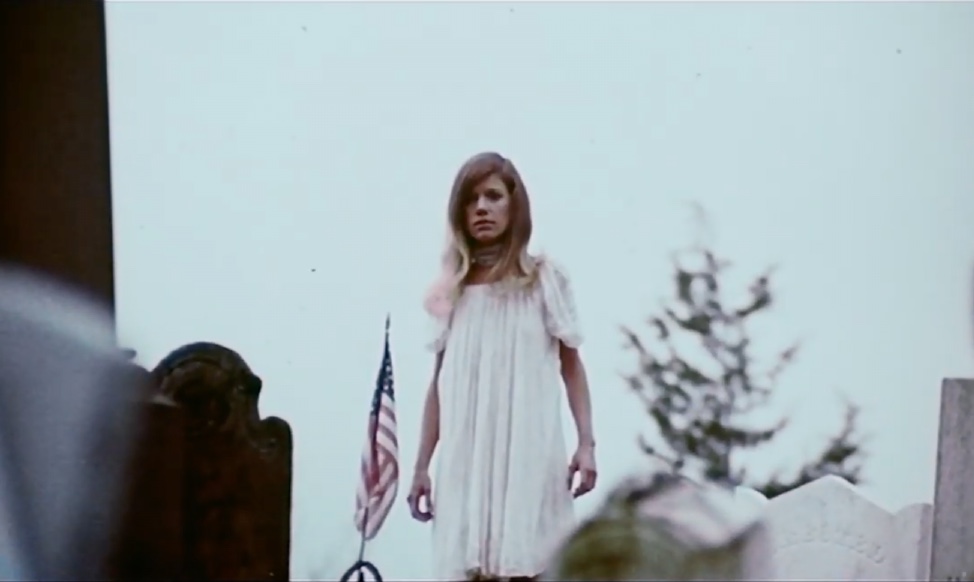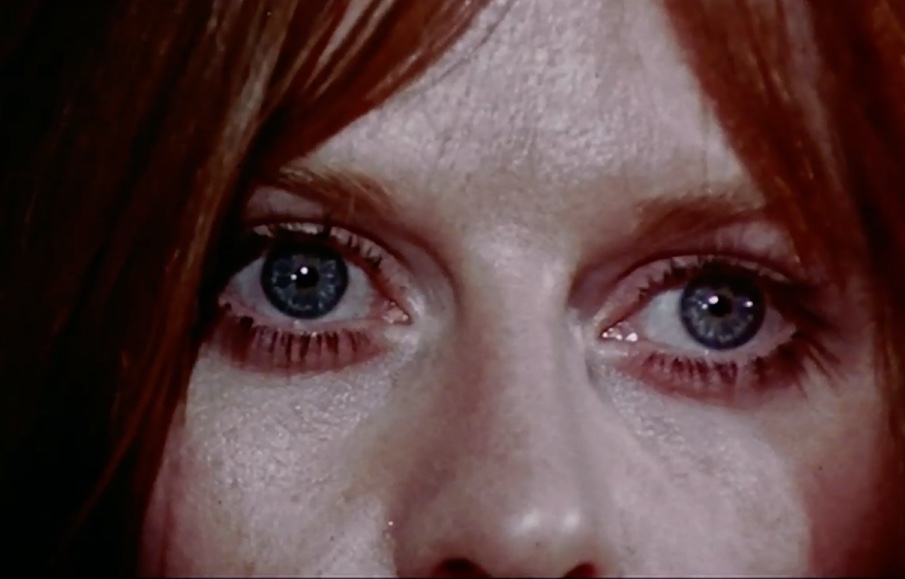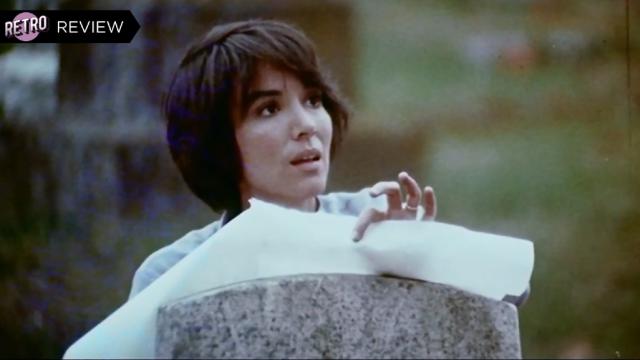With a title like Let’s Scare Jessica to Death, you’d forgiven for assuming this low-budget cult movie arrived as part of the post-Friday the 13th wave of 1980s slashers, especially considering its lakeside setting. But it came out in 1971 — and 50 years later it’s still unsettling in ways few other movies can claim.
That’s mostly due to the main character, played by Zohra Lampert. The performance is full of unexpected choices — like being ecstatically excited at odd times — that help set the tone for the movie, which aims to confuse the viewer as to what’s actually happening and what’s occurring solely inside Jessica’s mind.
The set-up is that Jessica has just emerged from a psychiatric hospital after a six-month stay; her diagnosis is never specified, but she was seeing and hearing things (like her dead father) and believing them to be real. Her husband, Duncan (Barton Heyman), has left his orchestra gig in New York and spent his savings on a ramshackle farmhouse in Connecticut, hoping to help Jessica continue her recovery and also, it’s implied, to repair the marriage that’s been strained by her illness and absence.
[referenced id=”1033339″ url=”https://gizmodo.com.au/2017/04/10-banned-censored-and-controversial-movies-that-are-now-cult-classics/” thumb=”https://gizmodo.com.au/wp-content/uploads/2017/03/30/wep36kundu5cfniaseeu-300×169.jpg” title=”10 Banned, Censored, And Controversial Movies That Are Now Cult Classics” excerpt=”Recently, we shared a clip from Ken Russell’s The Devils, a racy 1971 horror film that’s finally available for streaming on Shudder after years of obscurity. That got us thinking about other cult movies once deemed so scandalous they were either censored, banned, or taken out of circulation for years.”]
It’s an optimistic plan, and Duncan’s buddy Woody (Kevin O’Connor) comes along to help them get the apple orchard on the property up and running. But even before they arrive at “the old Bishop place,” as it’s called, Let’s Scare Jessica to Death sets a mood of unease. Instead of a regular car or truck, Duncan drives a hearse, ostensibly because he can fit his gigantic string bass (not coincidentally, its bulky case looks like a coffin) in the back. The locals take one look at the trio and dub them “hippies” and “creeps,” but there’s something decidedly off about the townies, too — they’re all craggy old men, for one thing, and upon closer inspection, most are either sporting bandages or have strange scars.
Then, when Jessica is taking some gravestone rubbings (a macabre hobby she embraces with intense enthusiasm), she spots a strange blonde girl who stares at her from the edge of the cemetery before disappearing. Considering Jessica’s documented history of seeing things that aren’t there, we wonder if there really was a girl standing there — and so does Jessica. Throughout the film, her self-doubt manifests in a voice-over that sometimes enunciates her thoughts (“Don’t tell them, they won’t believe you”), but is more often a strange voice that seems to be barging into her consciousness. When they arrive at the house, that latter voice hisses “Jessica, why have you come here?” The movie leaves it up to us to decide whether or not Jessica is really receiving psychic messages, or if it’s her own anxiety doing the talking.

When Jessica spies a different mysterious young woman sitting on the porch of her new home, she’s instantly on edge. But Duncan sees her too — her name is Emily (Mariclare Costello), a drifter who’d been camping out in a house she assumed was abandoned — and Jessica is so relieved that she invites Emily to stay the night as their guest.
You could probably point to that moment as when Let’s Scare Jessica to Death takes a more overt turn into horror, but our lead is already in struggle mode even before the pretty Emily — who is immediately flirty with Duncan, something that Jessica picks up on while also noticing he’s enjoying the attention — butts her way into what’s supposed to be the couple’s fresh start. But Jessica allows Emily’s insidious presence to gradually worm its way into the plot, much like the movie’s supernatural element, which doesn’t really begin to manifest until act three.
Though Emily’s true intentions, not to mention her true identity, soon become a pressing issue, the plot is mostly driven by the twists and turns of Jessica’s steadily fracturing psyche. She is the ultimate unreliable narrator, a woman on the verge of a breakdown who is already broken-down to begin with. When the hostile voice within reminds her “I’m still here, I’m in your blood,” you wonder if it’s Emily getting in Jessica’s head, or more so her mental illness taunting her that she’ll never be able to fully recover.
As the events of Let’s Scare Jessica to Death get weirder and Jessica’s encounters around the farm get scarier, she’s filled with frantic worry that not only will her husband not believe her, he’ll think she’s getting sick again — which of course he eventually does. The spare musical score and the sound design, which at times makes it seem like the house has a heartbeat, only elevate Jessica’s downward spiral, while the movie doles out freaky quirks that encourage the audience to start disbelieving their own eyes and ears after a while — like when Jessica visits a spectacularly cacophonous chicken coop to pick up some eggs, or when she adopts a creature she repeatedly refers to as a “mole” when it is obviously a mouse.

Directed and co-written by John D. Hancock, whose varied career would later include baseball drama Bang the Drum Slowly and holiday fantasy Prancer, Let’s Scare Jessica to Death has elements that might feel familiar to contemporary viewers. That’s likely owing to the fact that it influenced countless horror movies that came after. But 1971 was pre-Halloween, pre-Black Christmas, even pre-Last House on the Left; while there’s some Rosemary’s Baby (1968), The Haunting (1963), and Carnival of Souls (1962) in its DNA, it also takes inspiration from classic gothic tale Carmilla and Henry James’ oft-adapted 1898 novella The Turn of the Screw. For anyone really wanting to go all out, Jessica would make an outstanding double-feature with Mario Bava’s classic giallo Bay of Blood, which was also released in 1971 and is also about country-home terrors, albeit with far more graphic violence.
Let’s Scare Jessica to Death ends exactly as it begins, with Jessica adrift in a rowboat under a golden sun — very much like the exhausted protagonist would find herself a decade later at the end of Friday the 13th. We hear the same lines repeated from Jessica’s opening voice-over — “Nightmares or dreams, madness or sanity, I don’t know which is which” — and now we understand why she feels so scrambled.
The final strange detail about this movie is that incredible title, which implies that some kind of conspiratorial effort will be put forth to send Jessica to her doom. The fact that quotation marks appear around the title when it appears on screen (“Let’s Scare Jessica to Death”) make it seem even more like something lifted from spoken dialogue. But the most powerful antagonist of Let’s Scare Jessica to Death is Jessica herself — and the “us” implied by that “let’s” can only lead back to one place: the disturbed chorus that dwells within her own mind.
[referenced id=”1664706″ url=”https://gizmodo.com.au/2021/01/all-the-sci-fi-fantasy-and-horror-films-to-look-forward-to-in-2021-hopefully/” thumb=”https://gizmodo.com.au/wp-content/uploads/2020/12/15/dune-movie-books-300×154.png” title=”All the Sci-Fi, Fantasy, and Horror Films to Look Forward to in 2021″ excerpt=”You are not experiencing déjà vu. A huge percentage of films from our 2020 movie preview are once again here on our 2021 preview. But the good news is, there’s still a lot of great stuff to look forward to.”]
